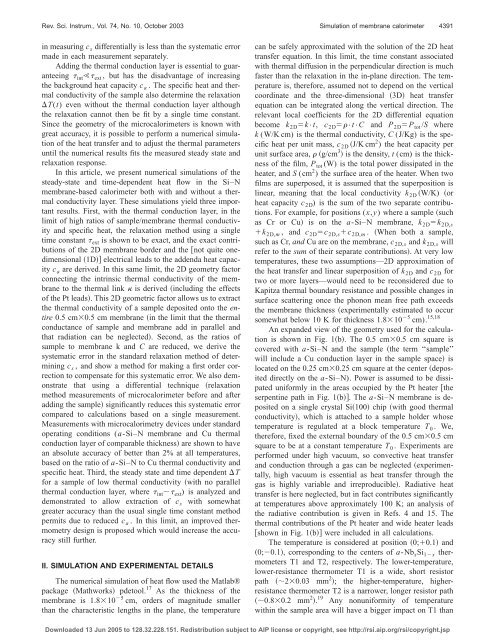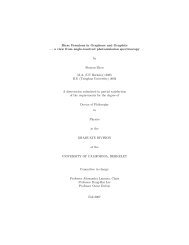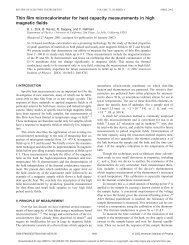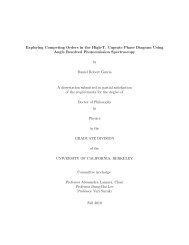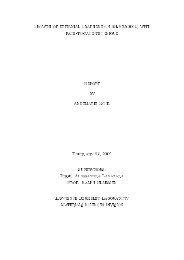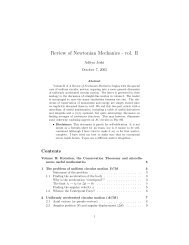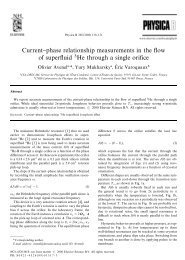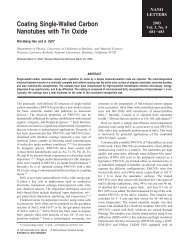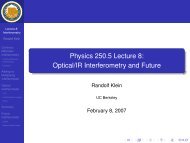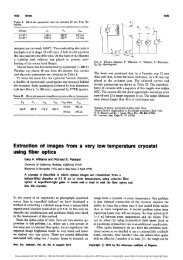Numerical simulation of the heat transfer in amorphous ... - Physics
Numerical simulation of the heat transfer in amorphous ... - Physics
Numerical simulation of the heat transfer in amorphous ... - Physics
Create successful ePaper yourself
Turn your PDF publications into a flip-book with our unique Google optimized e-Paper software.
Rev. Sci. Instrum., Vol. 74, No. 10, October 2003<br />
Simulation <strong>of</strong> membrane calorimeter<br />
4391<br />
<strong>in</strong> measur<strong>in</strong>g c s differentially is less than <strong>the</strong> systematic error<br />
made <strong>in</strong> each measurement separately.<br />
Add<strong>in</strong>g <strong>the</strong> <strong>the</strong>rmal conduction layer is essential to guarantee<strong>in</strong>g<br />
<strong>in</strong>t ext , but has <strong>the</strong> disadvantage <strong>of</strong> <strong>in</strong>creas<strong>in</strong>g<br />
<strong>the</strong> background <strong>heat</strong> capacity c a . The specific <strong>heat</strong> and <strong>the</strong>rmal<br />
conductivity <strong>of</strong> <strong>the</strong> sample also determ<strong>in</strong>e <strong>the</strong> relaxation<br />
T(t) even without <strong>the</strong> <strong>the</strong>rmal conduction layer although<br />
<strong>the</strong> relaxation cannot <strong>the</strong>n be fit by a s<strong>in</strong>gle time constant.<br />
S<strong>in</strong>ce <strong>the</strong> geometry <strong>of</strong> <strong>the</strong> microcalorimeters is known with<br />
great accuracy, it is possible to perform a numerical <strong>simulation</strong><br />
<strong>of</strong> <strong>the</strong> <strong>heat</strong> <strong>transfer</strong> and to adjust <strong>the</strong> <strong>the</strong>rmal parameters<br />
until <strong>the</strong> numerical results fits <strong>the</strong> measured steady state and<br />
relaxation response.<br />
In this article, we present numerical <strong>simulation</strong>s <strong>of</strong> <strong>the</strong><br />
steady-state and time-dependent <strong>heat</strong> flow <strong>in</strong> <strong>the</strong> Si–N<br />
membrane-based calorimeter both with and without a <strong>the</strong>rmal<br />
conductivity layer. These <strong>simulation</strong>s yield three important<br />
results. First, with <strong>the</strong> <strong>the</strong>rmal conduction layer, <strong>in</strong> <strong>the</strong><br />
limit <strong>of</strong> high ratios <strong>of</strong> sample/membrane <strong>the</strong>rmal conductivity<br />
and specific <strong>heat</strong>, <strong>the</strong> relaxation method us<strong>in</strong>g a s<strong>in</strong>gle<br />
time constant ext is shown to be exact, and <strong>the</strong> exact contributions<br />
<strong>of</strong> <strong>the</strong> 2D membrane border and <strong>the</strong> not quite onedimensional<br />
1D electrical leads to <strong>the</strong> addenda <strong>heat</strong> capacity<br />
c a are derived. In this same limit, <strong>the</strong> 2D geometry factor<br />
connect<strong>in</strong>g <strong>the</strong> <strong>in</strong>tr<strong>in</strong>sic <strong>the</strong>rmal conductivity <strong>of</strong> <strong>the</strong> membrane<br />
to <strong>the</strong> <strong>the</strong>rmal l<strong>in</strong>k is derived <strong>in</strong>clud<strong>in</strong>g <strong>the</strong> effects<br />
<strong>of</strong> <strong>the</strong> Pt leads. This 2D geometric factor allows us to extract<br />
<strong>the</strong> <strong>the</strong>rmal conductivity <strong>of</strong> a sample deposited onto <strong>the</strong> entire<br />
0.5 cm0.5 cm membrane <strong>in</strong> <strong>the</strong> limit that <strong>the</strong> <strong>the</strong>rmal<br />
conductance <strong>of</strong> sample and membrane add <strong>in</strong> parallel and<br />
that radiation can be neglected. Second, as <strong>the</strong> ratios <strong>of</strong><br />
sample to membrane k and C are reduced, we derive <strong>the</strong><br />
systematic error <strong>in</strong> <strong>the</strong> standard relaxation method <strong>of</strong> determ<strong>in</strong><strong>in</strong>g<br />
c s , and show a method for mak<strong>in</strong>g a first order correction<br />
to compensate for this systematic error. We also demonstrate<br />
that us<strong>in</strong>g a differential technique relaxation<br />
method measurements <strong>of</strong> microcalorimeter before and after<br />
add<strong>in</strong>g <strong>the</strong> sample significantly reduces this systematic error<br />
compared to calculations based on a s<strong>in</strong>gle measurement.<br />
Measurements with microcalorimetry devices under standard<br />
operat<strong>in</strong>g conditions (a-Si–N membrane and Cu <strong>the</strong>rmal<br />
conduction layer <strong>of</strong> comparable thickness are shown to have<br />
an absolute accuracy <strong>of</strong> better than 2% at all temperatures,<br />
based on <strong>the</strong> ratio <strong>of</strong> a-Si–N to Cu <strong>the</strong>rmal conductivity and<br />
specific <strong>heat</strong>. Third, <strong>the</strong> steady state and time dependent T<br />
for a sample <strong>of</strong> low <strong>the</strong>rmal conductivity with no parallel<br />
<strong>the</strong>rmal conduction layer, where <strong>in</strong>t ext ) is analyzed and<br />
demonstrated to allow extraction <strong>of</strong> c s with somewhat<br />
greater accuracy than <strong>the</strong> usual s<strong>in</strong>gle time constant method<br />
permits due to reduced c a . In this limit, an improved <strong>the</strong>rmometry<br />
design is proposed which would <strong>in</strong>crease <strong>the</strong> accuracy<br />
still fur<strong>the</strong>r.<br />
II. SIMULATION AND EXPERIMENTAL DETAILS<br />
The numerical <strong>simulation</strong> <strong>of</strong> <strong>heat</strong> flow used <strong>the</strong> Matlab®<br />
package Mathworks pdetool. 17 As <strong>the</strong> thickness <strong>of</strong> <strong>the</strong><br />
membrane is 1.810 5 cm, orders <strong>of</strong> magnitude smaller<br />
than <strong>the</strong> characteristic lengths <strong>in</strong> <strong>the</strong> plane, <strong>the</strong> temperature<br />
can be safely approximated with <strong>the</strong> solution <strong>of</strong> <strong>the</strong> 2D <strong>heat</strong><br />
<strong>transfer</strong> equation. In this limit, <strong>the</strong> time constant associated<br />
with <strong>the</strong>rmal diffusion <strong>in</strong> <strong>the</strong> perpendicular direction is much<br />
faster than <strong>the</strong> relaxation <strong>in</strong> <strong>the</strong> <strong>in</strong>-plane direction. The temperature<br />
is, <strong>the</strong>refore, assumed not to depend on <strong>the</strong> vertical<br />
coord<strong>in</strong>ate and <strong>the</strong> three-dimensional 3D <strong>heat</strong> <strong>transfer</strong><br />
equation can be <strong>in</strong>tegrated along <strong>the</strong> vertical direction. The<br />
relevant local coefficients for <strong>the</strong> 2D differential equation<br />
become k 2D k•t, c 2D •t•C and P 2D P tot /S where<br />
k (W/K cm) is <strong>the</strong> <strong>the</strong>rmal conductivity, C (J/Kg) is <strong>the</strong> specific<br />
<strong>heat</strong> per unit mass, c 2D J/K cm 2 ) <strong>the</strong> <strong>heat</strong> capacity per<br />
unit surface area, g/cm 3 is <strong>the</strong> density, t (cm) is <strong>the</strong> thickness<br />
<strong>of</strong> <strong>the</strong> film, P tot (W) is <strong>the</strong> total power dissipated <strong>in</strong> <strong>the</strong><br />
<strong>heat</strong>er, and S (cm 2 ) <strong>the</strong> surface area <strong>of</strong> <strong>the</strong> <strong>heat</strong>er. When two<br />
films are superposed, it is assumed that <strong>the</strong> superposition is<br />
l<strong>in</strong>ear, mean<strong>in</strong>g that <strong>the</strong> local conductivity k 2D W/K) or<br />
<strong>heat</strong> capacity c 2D ) is <strong>the</strong> sum <strong>of</strong> <strong>the</strong> two separate contributions.<br />
For example, for positions (x,y) where a sample such<br />
as Cr or Cu is on <strong>the</strong> a-Si–N membrane, k 2D k 2D,s<br />
k 2D,m , and c 2D c 2D,s c 2D,m . When both a sample,<br />
such as Cr, and Cu are on <strong>the</strong> membrane, c 2D,s and k 2D,s will<br />
refer to <strong>the</strong> sum <strong>of</strong> <strong>the</strong>ir separate contributions. At very low<br />
temperatures, <strong>the</strong>se two assumptions—2D approximation <strong>of</strong><br />
<strong>the</strong> <strong>heat</strong> <strong>transfer</strong> and l<strong>in</strong>ear superposition <strong>of</strong> k 2D and c 2D for<br />
two or more layers—would need to be reconsidered due to<br />
Kapitza <strong>the</strong>rmal boundary resistance and possible changes <strong>in</strong><br />
surface scatter<strong>in</strong>g once <strong>the</strong> phonon mean free path exceeds<br />
<strong>the</strong> membrane thickness experimentally estimated to occur<br />
somewhat below 10 K for thickness 1.810 5 cm). 15,18<br />
An expanded view <strong>of</strong> <strong>the</strong> geometry used for <strong>the</strong> calculation<br />
is shown <strong>in</strong> Fig. 1b. The 0.5 cm0.5 cm square is<br />
covered with a-Si–N and <strong>the</strong> sample <strong>the</strong> term ‘‘sample’’<br />
will <strong>in</strong>clude a Cu conduction layer <strong>in</strong> <strong>the</strong> sample space is<br />
located on <strong>the</strong> 0.25 cm0.25 cm square at <strong>the</strong> center deposited<br />
directly on <strong>the</strong> a-Si–N). Power is assumed to be dissipated<br />
uniformly <strong>in</strong> <strong>the</strong> areas occupied by <strong>the</strong> Pt <strong>heat</strong>er <strong>the</strong><br />
serpent<strong>in</strong>e path <strong>in</strong> Fig. 1b. The a-Si–N membrane is deposited<br />
on a s<strong>in</strong>gle crystal Si100 chip with good <strong>the</strong>rmal<br />
conductivity, which is attached to a sample holder whose<br />
temperature is regulated at a block temperature T 0 . We,<br />
<strong>the</strong>refore, fixed <strong>the</strong> external boundary <strong>of</strong> <strong>the</strong> 0.5 cm0.5 cm<br />
square to be at a constant temperature T 0 . Experiments are<br />
performed under high vacuum, so convective <strong>heat</strong> <strong>transfer</strong><br />
and conduction through a gas can be neglected experimentally,<br />
high vacuum is essential as <strong>heat</strong> <strong>transfer</strong> through <strong>the</strong><br />
gas is highly variable and irreproducible. Radiative <strong>heat</strong><br />
<strong>transfer</strong> is here neglected, but <strong>in</strong> fact contributes significantly<br />
at temperatures above approximately 100 K; an analysis <strong>of</strong><br />
<strong>the</strong> radiative contribution is given <strong>in</strong> Refs. 4 and 15. The<br />
<strong>the</strong>rmal contributions <strong>of</strong> <strong>the</strong> Pt <strong>heat</strong>er and wide <strong>heat</strong>er leads<br />
shown <strong>in</strong> Fig. 1b were <strong>in</strong>cluded <strong>in</strong> all calculations.<br />
The temperature is considered at position 0;0.1 and<br />
0;0.1, correspond<strong>in</strong>g to <strong>the</strong> centers <strong>of</strong> a-Nb x Si 1x <strong>the</strong>rmometers<br />
T1 and T2, respectively. The lower-temperature,<br />
lower-resistance <strong>the</strong>rmometer T1 is a wide, short resistor<br />
path 20.03 mm 2 ; <strong>the</strong> higher-temperature, higherresistance<br />
<strong>the</strong>rmometer T2 is a narrower, longer resistor path<br />
0.80.2 mm 2 . 19 Any nonuniformity <strong>of</strong> temperature<br />
with<strong>in</strong> <strong>the</strong> sample area will have a bigger impact on T1 than<br />
Downloaded 13 Jun 2005 to 128.32.228.151. Redistribution subject to AIP license or copyright, see http://rsi.aip.org/rsi/copyright.jsp


